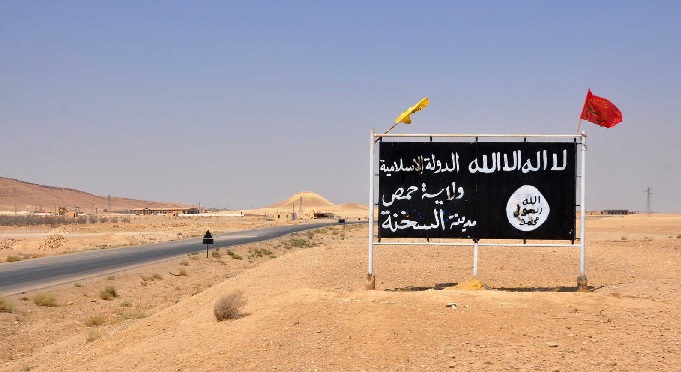
Militants linked to the Islamic State (IS) terror group have increased their attacks in recent weeks against military forces and civilians in the desert region of Syria.
Experts believe the militant group now presents a major insurgent threat throughout the desert, known as the Badiya, a year after U.S.-backed forces declared the territorial defeat of the group in eastern Syria.
Last month, IS announced via its Amaq News Agency that IS fighters would begin a new operation dubbed as “the saga of exhaustion 2” against Syrian government forces and allied militias. It reportedly is a second phase of a previous campaign started by the group’s former leader Abu Bakr al-Baghdadi, who was killed last August in a U.S. operation in the northwestern Syrian province of Idlib.
Local news outlets have reported several attacks carried out by IS militants against forces loyal to the Syrian President Bashar al-Assad in the sprawling desert area, including the Deir al-Zour province in eastern Syria, where U.S.-backed forces also control some strategic parts.
In those attacks, at least 15 Syrian government soldiers and allied Iranian-backed militia fighters were killed and dozens more were wounded.
Incomplete victory
The recent uptick of IS violence in this area is largely because military advances made by Syrian troops and their allies against IS, also known as ISIS, in previous years were incomplete, experts say.
“Assad’s forces and his allies made swift gains in the Badiya campaign against ISIS in 2017 because ISIS tactically withdrew from many areas of the Badiya before pro-regime forces moved in to take them from the would-be caliphate,” said Nicholas Heras, a Syria expert at the Institute for the Study of War (ISW).
The desert region is a scarcely populated area, which allows IS to hide its fighters and military hardware, he said.
“ISIS went to ground in the Badiya, which allows the organization to maintain the ability to use small groups of heavily armed fighters to strike at will at isolated Assad regime outposts in this large region, or use sleeper cell operatives to assassinate local regime officials,” Heras told VOA, noting that IS’s so-called “caliphate has become the vengeful ghost of the Syrian Desert.”
Proving relevance
Claiming such attacks could be a major military achievement for IS militants now that they no longer hold territory in Syria. For them, it is more about how to demonstrate relevance in the Syrian conflict, some experts charge.
IS “attacks against Syrian regime troops and others come after long and precise planning with whatever resources they still have in Syria,” said Sadradeen Kinno, a Syrian researcher who closely follows Islamist insurgency in the country.
Kinno said carrying out coordinated attacks once or twice a month “is a big win for IS, because this is not about holding territory anymore, it’s about proving that the group still exists.”
Sleeper cells
IS militants also have resorted to extortion and kidnapping for ransom as a way to fund their terrorist activities. Such trends are particularly rampant in areas under the control of the Syrian Democratic Forces (SDF), a U.S.-backed military alliance that has been an effective force in the fight against IS.
“There is a growing lawlessness in many parts of Deir al-Zour that are under SDF control,” said Omar Abu Layla, director of Deir Ezzor 24, a news and research group focused on developments in eastern Syria.
Abu Layla claimed that IS “operatives are roaming almost freely and SDF’s local fighters don’t seem to be alarmed about this dangerous phenomenon.”
For example, he said, on Monday several IS militants carried out an assassination attempt “in broad daylight” against a civilian in the town of al-Shuhail in Deir al-Zour “without even wearing masks as they usually do.”
This shows that local SDF fighters are not capable of bringing stability to the area, Abu Layla told VOA.
On Sunday, suspected IS gunmen killed an SDF commander in an attack on the town of al-Sabha in eastern Deir al-Zour.
SDF officials admit that IS sleeper cells continue to pose a threat to their stabilization efforts in areas freed in recent years from the terror group.
U.S. support
U.S. military officials say they will continue to support the SDF in their counterterrorism efforts in eastern Syria.
“The Syrian Democratic Forces have the backing of the international military coalition as they hunt for ISIS sleeper cells in the Middle Euphrates River Valley and Badiya Desert,” the U.S.-led coalition spokesman Col. Myles Caggins said.
“The ISIS remnants are a threat and we have seen them assassinate tribal leaders, ordinary shepherds, steal, and make attacks on SDF troops in some areas,” he told VOA, noting, “Local councils and tribes are working closely with the SDF to keep pressure on ISIS outlaws.”
With support from the coalition, SDF recently arrested a senior IS operative in Hasaka province, who was a high-ranking health official when the terror group was ruling the area.
 Eurasia Press & News
Eurasia Press & News

